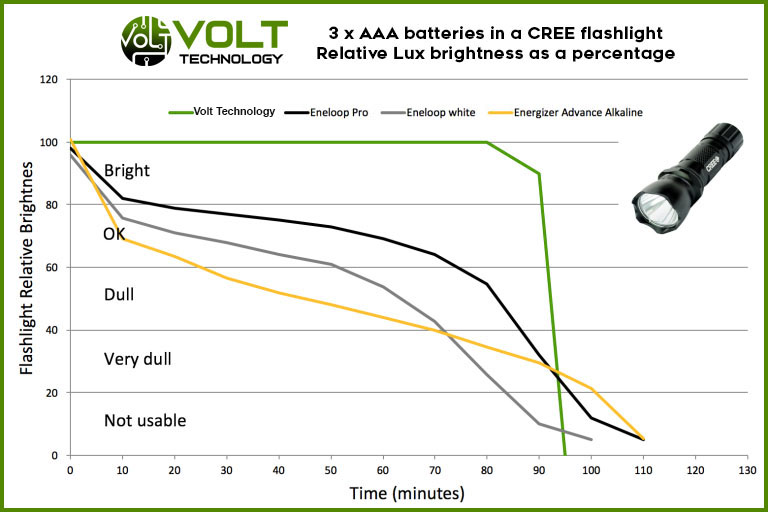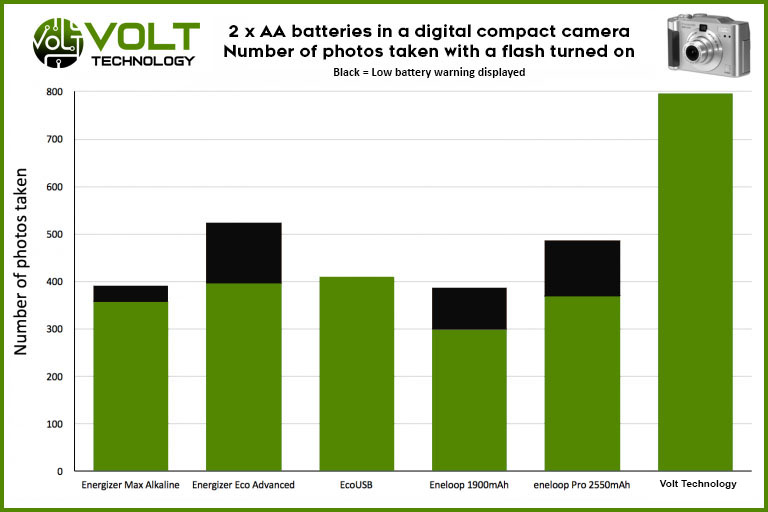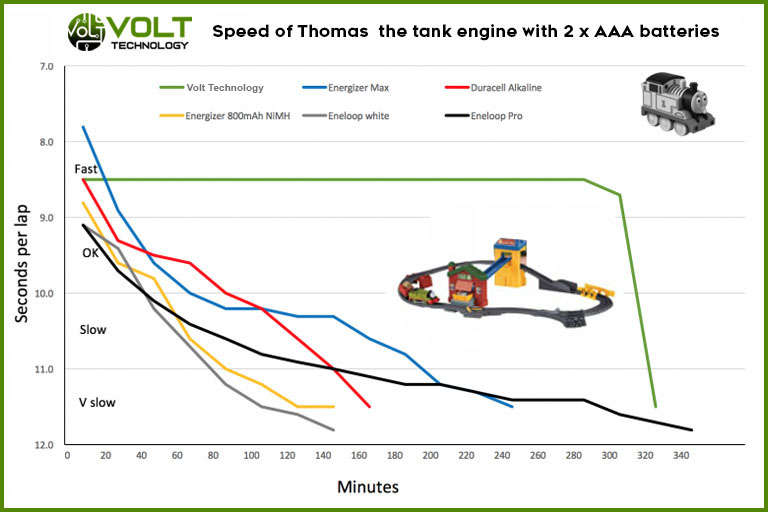
We tested the Volt Technology performance against the performance of regular batteries in four commonly used devices – A flashlight, Digital camera, Child’s toy and an Electric toothbrush. The results demonstrate conclusively that batteries with Volt’s technology maintained its higher power output and performance while the regular batteries faded.

The results in this graph are from tests carried out with 3 x AAA batteries in a CREE LED flashlight.
Batteries with Volt’s technology allow a flashlight to shine at full brightness of longer than any available NiMH rechargeable or Alkaline disposable battery.
A brightness of less than 65% was in the testers opinion a level that would warrant replacing the batteries as the brightness was not at a perceived good level. Based on 65% or above being a usable level, the Volt Technology battery lasted for 5x longer than the Alkaline and up to 2x longer than a NiMH.
The results in the graph are from tests carried out with 2 x AA batteries in a digital compact camera until the camera would no longer take photos with the flash turned on.
The Volt powered camera was ready to take photos quickly for all 798 photos. Long lasting, fast flash recharge time, more photos between recharges than any other rechargeable battery.
A Volt Technology battery will take more photos than any NiMH rechargeable or Alkaline disposable battery.
The results in the graph are from tests carried out with 2 x AAA batteries in a motorized Thomas toy train until the train no longer had the power to climb the small rise.
Under 10 seconds per lap = Good speed. The train moved easily around the track.
10 to 11 seconds per lap = Slow speed. While the train moved around the track reasonably slowly, it was very slow up the small rise.
Over 11 seconds per lap = Very slow. Once the train had slowed to approximately 11.5 seconds per lap, it didn’t have the power to climb the small rise and the train stopped. A push would get the train moving again but normally only for a few laps.
The test with Volt’s technology battery operated at a good speed (under 10 seconds per lap) for up to 7x longer than a NiMH rechargeable or Alkaline disposable battery.
The results in the graph are from tests carried out with 2 x AAA batteries in an electric toothbrush until it no longer had the power to vibrate with a light press on the brush.
Over 5,500RPM = Excellent speed. Toothbrush works perfectly with a strong vibration.
5,000 to 5,500RPM = Very good speed. The toothbrush worked very well – slightly slower than excellent but perfectly operational.
4,500 to 5,000RPM = Good speed. The toothbrush worked well – slightly slower than very good but fast enough to be operational.
4,000 to 4,500RPM = Just OK speed. The toothbrush worked but not with any real power.
3,500 to 4,000RPM = Poor speed. The toothbrush vibrated however the speed was slow and there was little power. Frustrating to use.
3,000 to 3,500RPM = Very poor speed. Not enough speed to adequately clean teeth.
Less than 3,000RPM = Cuts out when pressed against teeth.
The Volt battery provided enough power to enable the electric toothbrush to operate effectively for significantly longer than any other NiMH rechargeable or Alkaline disposable battery.
Test results will vary depending on exact usage, test conditions and other factors. Results are intended as a guide only






